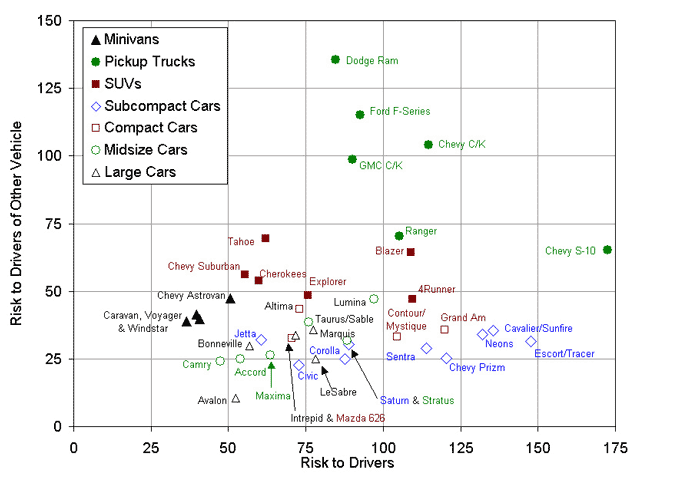Quote:
Originally Posted by Isaac Zackary

Thanks for your posts. I don't mean to sound so hard, you are making a valid point. But as to which car is safer than the other, you have to have the total risk calculated from the total statistics in order to determine which is safer, This graph isn't to date but it illustrates the point:

The Suburban is by far the safest SUV out there. For protecting its occupants, the Suburban is much better than your average car. I'm not sure which years this graph is from. I was trying to find one made by the same guy/company that in those years the Suburban was better than any other car or SUV, except Minivans. Statistically if you want safety, get a minivan. You are much less likely to die in a minivan than any other form of personal transportation.
Unless you show the total statistics, saying the Charger is safest is just opinion based on some half facts. A car can have very good crash test ratings. But how likely are you to get into an accident in the first place? I have to travel over steep, snow covered, mountain passes and you're telling me that I need a RWD Charger?
I don't have to do what I do. But I wouldn't call it a mistake. For years I lived with only a bicycle, and could do that again if I had to. Now talk about a safety issue! The car I have works perfectly fine for what I do. The whole reason I want to go from a 1985 VW diesel to a 2014 Toyota Prius is for safety concerns. That car seems like it will work for me in every which way possible. And how much safer is a Charger over a Prius? Do you have the statistics? |
Your chart isn’t even half the story. It’s 20-years out of date. Keep researching. An inaccurate reflection of reality is shown. Worse than biased (the questions presupposed). A pickup-based live-axle vehicle is WORST. Can’t steer, can’t maneuver, prone to rollover. When one carefully words WHAT to match a severely narrowed question, your reading of that chart is “the answer”. (The Avalon is roughly peer to my point about sedans). There’s more and better out there.
Avoiding serious death or injury is the criterion. Not which vehicle can best take a hit.
The vehicle able to get out of its own way AT SPEED is in the first tier of choices. What are the tech specs that make that so? Look into it. (Fred Puhn)
Second are questions of curb weight & wheelbase. Able to take multiple hits. I posted above where that graph peaks for efficiency. (And don’t knock the better ride qualities). A Prius and it’s cousins can’t take more than one hit.
The Charger (Mercedes) design is that result. It isnt by any mistake or coincidence. Its
Science!! (It’s also available AWD, but that kills FE).
Basic design trumps electronic bandaids. Which all SUVs are dependent upon. The physics of the thing should be obvious. 8th grade.
(FB, it’s no mistake that this chassis has the ability to put up to 700-HP to the ground. As you know, one can drop an engine like that into a Suburban, but the chances of seeing even half of that transmitted to the ground for a significant percentage of time is ridiculously small).
OP, cheap-to-run is part of low cost ownership. Do the rest of the math on all aspects. Insurance, tax, finance, depreciation and the rest. Fuel is less than half.
Length of ownership is “true” economy.
The well-designed sedan with the FE drivetrain (and fleet market) has ALWAYS been the economy choice. Long-lived, easily repaired, and low cost per mile of operation.
As before, a bad commute was your choice. How will you compound that mistake (is what you genuinely want to avoid)? Others move where opportunity exists. How many compromises can you make in the name of (whatever) before the risks outweigh feeding ego?
The fuel expense ISN'T the problem. All weather roads plus subsidized fuel have led you and many others to make decisions not warranted by better assessments of family well-being.
.